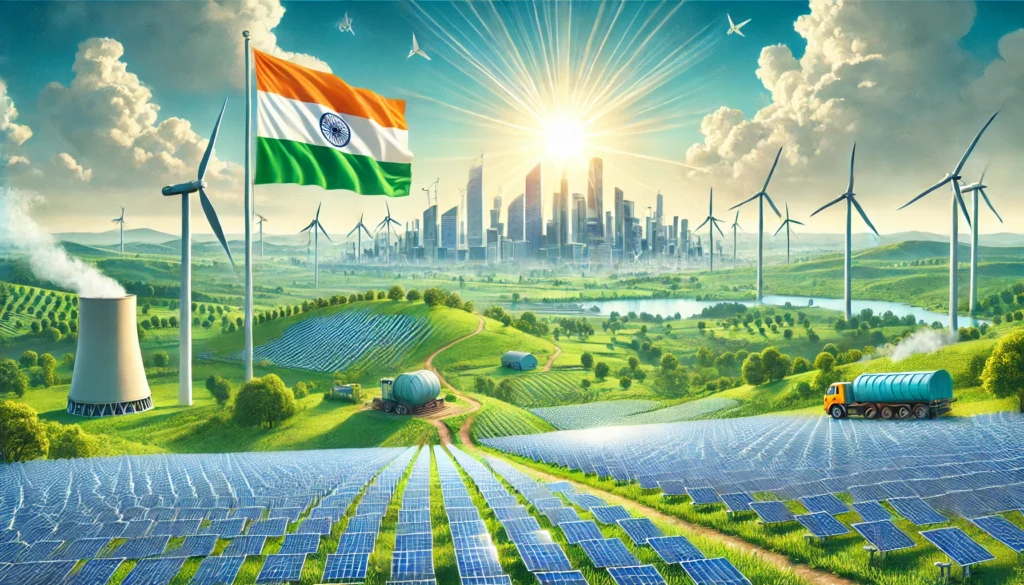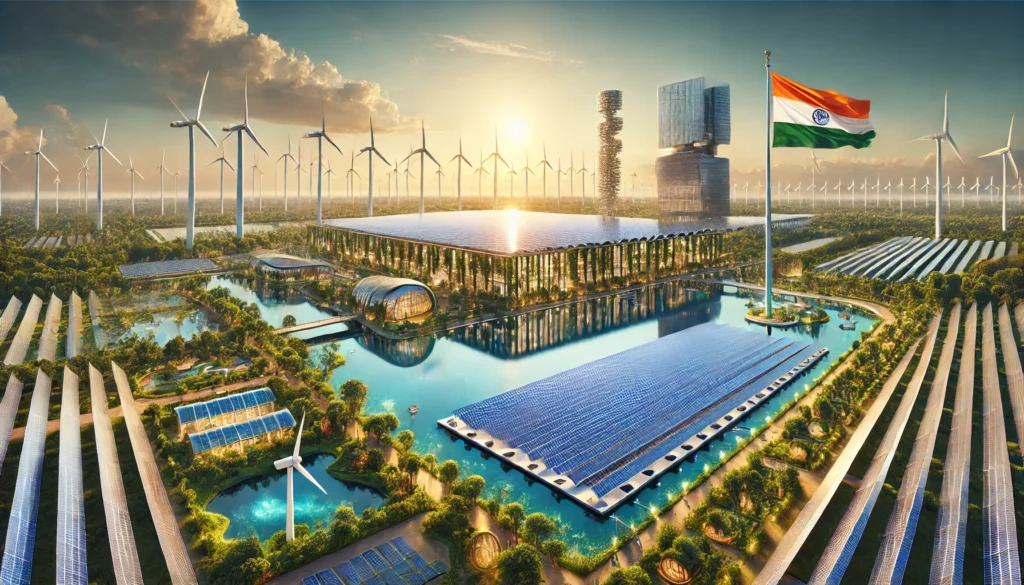India is emerging as a global leader in renewable energy, setting ambitious goals and making significant strides in the sector. Over the past decade, the country has witnessed remarkable growth in solar, wind, and biomass energy projects. With a clear focus on reducing carbon emissions and promoting sustainable development, India aims to achieve 500 GW of renewable energy capacity by 2030.

Key Milestones
India has achieved several milestones in the renewable energy space:
- Solar Power Boom: India has become the fifth-largest solar power producer globally. The construction of solar parks, especially the Pavagada Solar Park in Karnataka, has put India on the map. The cost of solar power has also dropped significantly, making it more accessible.
- Wind Energy Growth: India ranks fourth in the world for wind power capacity, with major installations in Tamil Nadu, Gujarat, and Maharashtra. These states are now contributing a significant share of electricity to the national grid.
- International Collaborations: India co-founded the International Solar Alliance (ISA), a global initiative to promote solar energy across 121 countries.
Future Prospects
The government is working on policies and incentives to attract private investments. With the increased focus on green hydrogen and energy storage solutions, India is positioned to become a leader in clean energy technologies. The transition to electric vehicles (EVs) is also expected to further drive the demand for renewable power.
Community Impact
Renewable energy is not just about large-scale projects. Communities are benefiting too, with solar microgrids lighting up remote villages. The sector also promises job creation, making renewable energy a win-win for the economy and environment.
Takeaway: The renewable energy revolution in India is real and gaining momentum. As both global and local players invest in this space, it’s important for individuals to stay informed and consider how they can be part of this movement, whether by adopting solar panels or choosing electric vehicles.
भारत में नवीकरणीय ऊर्जा का उदय: मील के पत्थर और भविष्य की संभावनाएं

भारत नवीकरणीय ऊर्जा के क्षेत्र में एक वैश्विक नेता के रूप में उभर रहा है। कार्बन उत्सर्जन को कम करने और सतत विकास को बढ़ावा देने के स्पष्ट उद्देश्य के साथ, भारत 2030 तक 500 गीगावाट नवीकरणीय ऊर्जा क्षमता प्राप्त करने का लक्ष्य रखता है। पिछले दशक में, देश ने सौर, पवन और बायोमास ऊर्जा परियोजनाओं में उल्लेखनीय वृद्धि देखी है।
प्रमुख मील के पत्थर
भारत ने नवीकरणीय ऊर्जा क्षेत्र में कई महत्वपूर्ण मील के पत्थर हासिल किए हैं:
- सौर ऊर्जा का उछाल: भारत वैश्विक स्तर पर पांचवां सबसे बड़ा सौर ऊर्जा उत्पादक बन गया है। कर्नाटक के पावागड़ा सौर पार्क जैसे सौर पार्कों का निर्माण देश को विश्व मानचित्र पर स्थापित कर रहा है। सौर ऊर्जा की लागत में भी काफी कमी आई है, जिससे यह अधिक सुलभ हो गया है।
- पवन ऊर्जा की वृद्धि: पवन ऊर्जा उत्पादन में भारत चौथे स्थान पर है, जिसमें तमिलनाडु, गुजरात और महाराष्ट्र प्रमुख योगदान दे रहे हैं। ये राज्य अब राष्ट्रीय ग्रिड में महत्वपूर्ण मात्रा में बिजली का योगदान कर रहे हैं।
- अंतर्राष्ट्रीय सहयोग: भारत ने अंतर्राष्ट्रीय सौर गठबंधन (ISA) की सह-स्थापना की, जो 121 देशों में सौर ऊर्जा को बढ़ावा देने की एक वैश्विक पहल है।
भविष्य की संभावनाएं
सरकार निजी निवेश को आकर्षित करने के लिए नीतियों और प्रोत्साहनों पर काम कर रही है। ग्रीन हाइड्रोजन और ऊर्जा भंडारण समाधानों पर बढ़ते ध्यान के साथ, भारत स्वच्छ ऊर्जा प्रौद्योगिकियों में अग्रणी बनने की स्थिति में है। इसके अलावा, इलेक्ट्रिक वाहनों (ईवी) की ओर बढ़ती प्रवृत्ति से नवीकरणीय ऊर्जा की मांग और बढ़ने की उम्मीद है।
सामुदायिक प्रभाव
नवीकरणीय ऊर्जा केवल बड़े पैमाने पर परियोजनाओं तक सीमित नहीं है। समुदाय भी इसका लाभ उठा रहे हैं, खासकर सौर माइक्रोग्रिड के जरिए जो दूरदराज के गांवों को रोशन कर रहे हैं। इस क्षेत्र में रोजगार सृजन की अपार संभावनाएं हैं, जिससे नवीकरणीय ऊर्जा आर्थिक और पर्यावरणीय दृष्टिकोण से फायदेमंद है।
निष्कर्ष: भारत में नवीकरणीय ऊर्जा क्रांति वास्तविक है और तेजी से गति पकड़ रही है। जैसे-जैसे वैश्विक और स्थानीय खिलाड़ी इस क्षेत्र में निवेश कर रहे हैं, यह जानना महत्वपूर्ण है कि हम इस आंदोलन का हिस्सा कैसे बन सकते हैं।
Follow my website for more interesting and insightful blogs!
